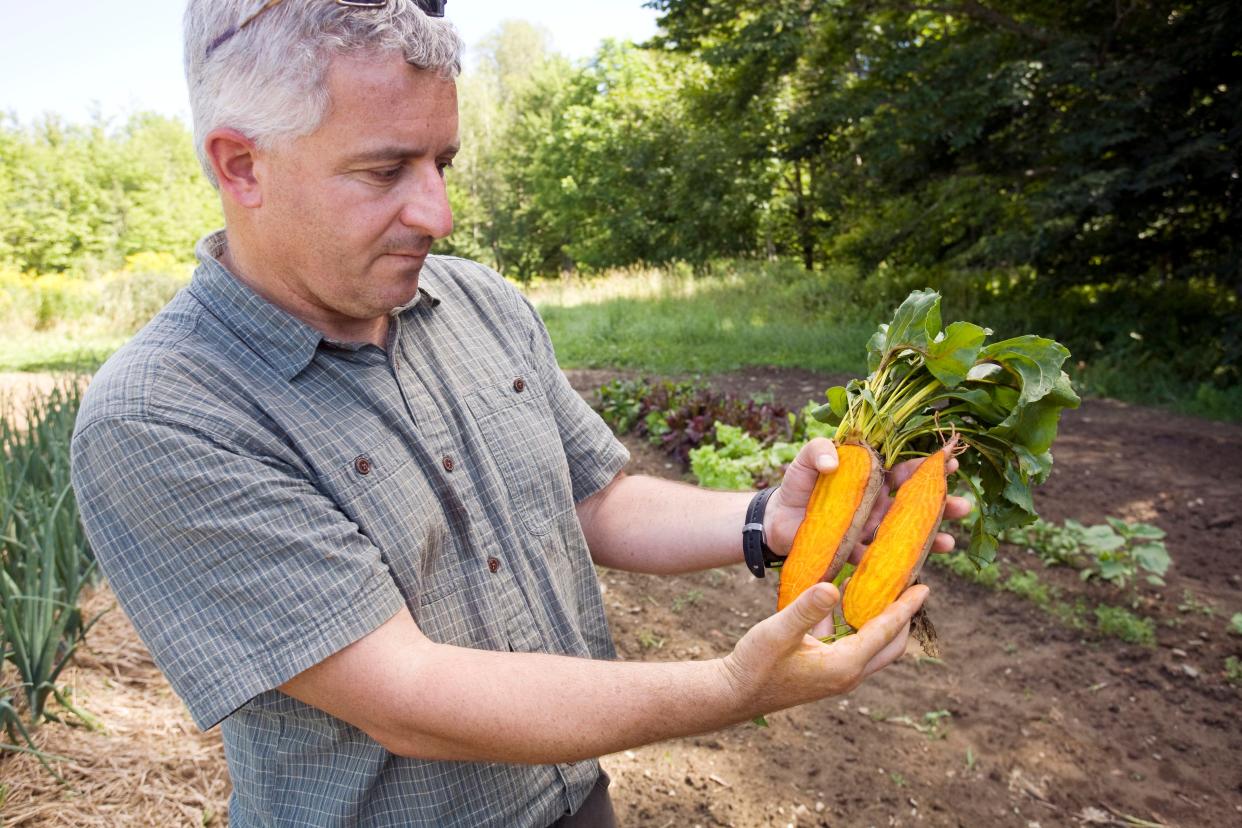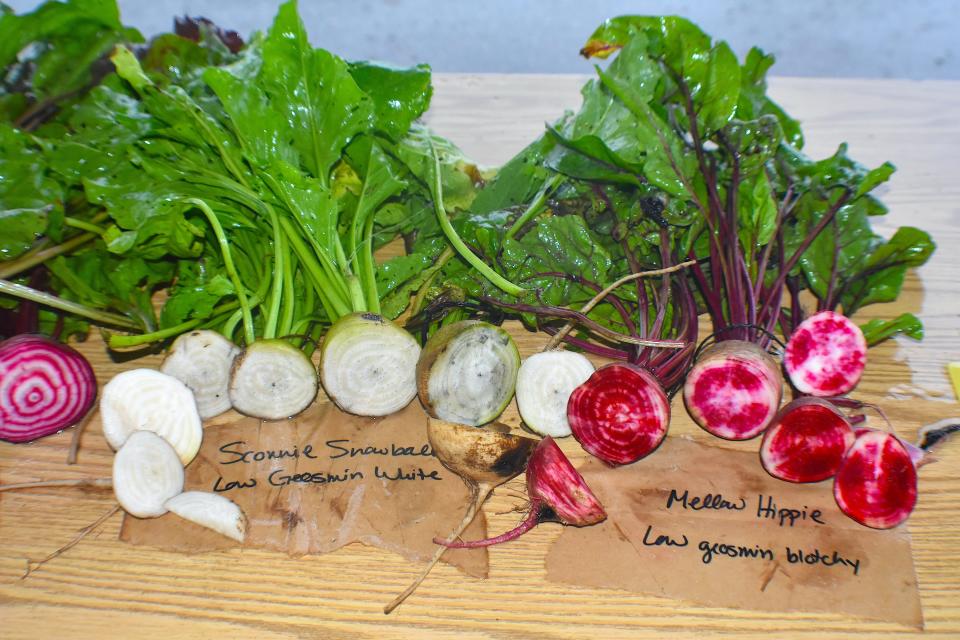UW professor is on a mission to grow a better-tasting beet

Whether you love beets or hate them, you probably haven't given them as much thought as Irwin Goldman.
A professor at the University of Wisconsin-Madison, Goldman is also former chair of the department of horticulture. The Goldman Lab there is even named after him. He and colleague Nick Breitbach spent decades trying to breed a better beet. Now the Badger Flame Beet is getting attention nationwide from growers and chefs as it becomes increasingly available.
Bred to be eaten raw, these sweet beets lack the earthy flavor that is a turnoff for so many. A father, Goldman’s goal was to create a beet that kids would eat raw as a snack, like a carrot. Of course, looks matter, too. The Badger Flame Beet also appeals because of its mesmerizing colors resembling a flame.
Badger Flame Beet seeds entered the commercial market a few years ago, but consumers still have to make a conscious effort to buy the seeds and beets themselves. Row 7 Seed Company in New York released a new limited batch of the seed in January. Other sellers with limited inventory include High Mowing Seeds and Nature & Nurture Seeds. While the beets themselves can still be hard to find unless you know a grower, Goldman has seen them on restaurant menus and notes Badger Flame Beets have been sold at Whole Foods and Wegmans.
Goldman, who has been at UW since 1992, talked with us about the UW program, and how teaming up with chefs and growers helped launch this new breed of beet.
How a kid from Skokie built a career breeding vegetables
I grew up not knowing even there was a field called plant breeding. I didn't realize it was a discipline. I had the fortune to go to the University of Illinois Urbana-Champaign, where my father went. I was always interested in nature, biology and genetics, but I was lucky enough to get a student job with a plant breeder. He was a soybean breeder, something you’d do in central Illinois. We went out to harvest some soybean plots, and I couldn’t believe how much it combined these things I loved. Working outside, with your hands, and the foundational science of genetics that underpinned everything, and the fact it was food and feeding people made it even better. That was over 40 years ago.

Seeds feed a growing need
When I arrived (at UW-Madison), the university in the mid-'90s as a public institution, we were giving our seeds away. Anybody who wanted the seeds we bred could get them for free. The university thought, probably, it is great that the public get this, but there is some way to get value if somebody sells that. WARF (the Wisconsin Alumni Research Foundation) became the entity that managed that for all the sciences, a separate nonprofit to benefit the university.
The seeds are licensed for WARF. Companies can get them for almost no money to trial, but if they decide to sell, they pay a royalty back to the university. It goes back to support the university, research, students and even our own lab. It is a way to capture the revenue of this work done here.
How his work differs from that of a home gardener
It has become so specialized. Traditionally they would save seeds. That’s what your grandmother did. Let some of the plants go to seed. ... There have been seed companies around for years and years, and now, particularly driven by hybrids, they use very specialized techniques. That requires background in science.
From leaf to root, there’s a long history
The beet has its origin in the Mediterranean as a leaf crop. It still grows there today as a wild plant. People in ancient Greece and Rome ate this leaf as a salad crop. It wasn’t until people began to work with this that they made a swollen root crop. This was just a little weed, and it happens this plant possesses tree rings. ... When you cut open a beet, you see rings. They grow all at once, not on an annual basis like trees. Because this plant has them, humans were able to blow it up like a balloon through selection. They made a swollen rooted vegetable. Ancient writers in Greece and Rome ate beets and talked about it. We know 2,000 years ago people were eating it. Then as the plant moved through Europe in relatively recent times, humans started selecting the plant for sugar to make the modern sugar beet.
The beginnings of the Badger Flame Beet
That project starts in 1995. The person who deserves a lot of credit for this work is Nick Breitbach, who worked at the university for a long time, a talented plant breeder. Our idea was to create something red-and-yellow striped. We wanted to make something elongated, kind of like a sweet potato. Most people are used to seeing beets round. We wanted something you could essentially eat raw, or you could eat it and it was not overwhelming with respect to the earthiness. One of the things I would hear is it tastes like dirt, it is too earthy.
How beets became this Badger’s building block
The polarizing nature of the vegetable was something that was on our minds. How could we make something you could give to a kid to eat for lunch, and they’d just snack on it instead of needing to cook it? We spent years selecting for that. Geosmin, it is the scent of the earth, the smell everybody knows if you take a shovel and put it in the soil. Everybody can detect that. It turns out some of our foods have earthiness in them. Beet is one. Chard has it. Spinach a little bit.
We selected away from it, and we selected for low levels of oxalic acid, something that in a lot of plants is a natural protectant, protects them from pathogens and pests, but gives a gritty mouth feel. If you eat the leaves of beets or chard and you get that weird feeling in the back of your mouth when you chew it raw, that’s from the oxalate abrading your mouth. The oxalic acid, it abrades like sandpaper.
We selected for low levels of oxalate, geosmin, color, shape and we came up with Badger Flame, Badger Torch, Badger Sunset. All of these are beets you can eat fresh. That’s the innovation — something you can cut up like celery or jicama and have as a sweet crunch.
Looking beyond the Badger Flame
We’ve developed a lot of different beets. Most haven’t yet emerged to see the light of day. They’re still in the stage of being tested and trialed by the seed companies. Then the seed has to be multiplied, which takes years really to get enough seed for a company to sell it. There are three or four of our seeds out there now. We’re hoping some of the recently developed ones will be chosen by seed companies and multiplied. It is a slow process.
How chefs can create demand
Dan Barber (chef/founder of Row 7 Seed Co.) had the idea to have plant breeders partner with chefs and other culinary professionals years before it became something we realized was important. He actually brought plant breeders and chefs together literally in the same room over a period of years to get people talking. Let’s talk about ways we could collaborate as we’re breeding...
He came to Wisconsin, to our fields. Every year we’d send a carload of our breeding material to New York. They’d taste it and send feedback. “This is terrible, can you change this?” It began a process of dialogue and thinking of what can you do with it in the kitchen? That has totally changed the system of how we work, honestly.
Something to think about at your next meal
To me, the more people understand about the provenance of the food they eat, starting with where it was grown and the farmers who grew it or the land that it was grown on, but also the process of breeding it, trialing, selecting it and growing it, that all makes us better citizens and humans. ... The more we understand the plants and their story, hopefully we will take better care of that world. That’s what I’m interested in.
If you want to learn about plant breeding and science
UW-Madison is just one of a number of UW system schools where you can learn horticulture and plant science. River Falls, Platteville and a number of the schools have an education in plant sciences. What is unique about Madison, we have this enormous research enterprise baked into the culture of the university. Every professor’s job is not just to teach classes, but to do research, bring in grants to support projects... Also, one of the parts in Madison is UW-Extension. The combination of research and extension and teaching is an incredible combination.
This article originally appeared on Milwaukee Journal Sentinel: Irwin Goldman is on a mission to grow a better-tasting beet

